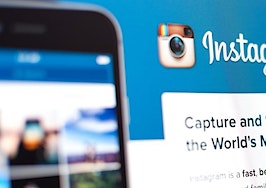- The ability to bring viewers directly to your Messenger gives you the opportunity to identify where that person is in the sales cycle without being intrusive.
- You lose more leads between the “cold” general interest and “warm” active interest sections than anywhere else.
- In-app messaging services feature an open-rate of more than 60 percent.
Advertising can only be worth as much as the number of people able to see it. And right now, there is no better place than mobile. Every nose in a phone is constantly being bombarded by content, and most of it is coming from apps.
A Nielsen study suggests that the average smartphone user spends 85 percent of his or her time on the device using apps. The most popular app in the world is Facebook’s Messenger, which was downloaded 59.7 million times during the first six months of 2016.
This popularity makes the launch of Facebook’s newest ad feature a perfect storm for marketers and business owners who are ready to take advantage.
Messenger as a destination
Businesses can now select Messenger as a destination for their website clicks objectives, as well as choose “Send Message” as a call-to-action to link to the app.
Up until now, users of Messenger have had to seek out your business and instigate a conversation to receive your messages. That policy still exists; however, now News Feed advertisements can bring those prospects right to your door. This is huge for starting conversations and generating leads.
To understand the effectiveness of this strategy, you need to understand the concept of the sales funnel. The average viewer who clicks on a Facebook ad is going to be near the top of the funnel — someone who doesn’t fully feel the need to do business with you, but is at least curious about your product.
Your goal after grabbing their attention is to usher them down the funnel to more meaningful, personal discussions on your offerings, and then they exit the funnel with a sale.
Previously, calls to action on News Feed ads would bring curious viewers to “learn more” by taking them to an appropriate section on your site. This is effective; however, it still lacks the personal touch that delivers prospects further down the sales funnel.
The ability to bring viewers directly to your Messenger gives you the opportunity to identify where that person is in the sales cycle without being intrusive.
The conversion rates along various stages of the sales funnel differ based on industry; however, one fact remains the same: You lose more leads between the “cold” general interest and “warm” active interest sections than anywhere else.
What the update means
Heading directly to Messenger from the News Feed serves two purposes, depending on the temperature of the lead:
- Cool leads, who definitely have an interest in your offering, can be warmed up immediately, rather than wasting their time and risk losing their attention with excessive cold content.
- Leads that were unlikely to take further steps can be warmed up via direct conversation, potentially creating sales where they previously wouldn’t have existed.
According to the 2016 Demand Generation Benchmark Report, more than 83 percent of marketers indicated that it wasn’t their goal to generate more leads, but rather to generate a higher percentage of quality leads.
Can you think of a better way to sift out uninterested leads by than by guiding your prospects directly into a conversation about your offerings?
Speaking of high percentages, Messenger provides a benefit over conventional web advertising regarding the likelihood your prospects will open your follow-up outreach.
Follow-up email outreach gives around a 10 percent chance the message will be opened, and it’s even less likely recipients will respond. In-app messaging services feature an open-rate of more than 60 percent.
Even prospects who opt-in to future messages might opt not to read them when it gets to their inbox. Messenger amplifies the likelihood that they see every message — the first, the last and the in-between.
It’s nice that you offer personalized attention to prospects or further content in your follow-up emails. It’s killer if you offer personalized attention, and further content in your follow-up in-app messages and your targets actually read it.
Using language as simple as “I’d be happy to chat with you regarding … ” is often enough to bring a prospect into the fold.
A more effective route
This new update is the best of both worlds: A segmented audience, just like the kind Facebook has been offering for years, but with engagement previously unheard of.
If you’re worried your blog posts and other print content at the top of the funnel will be rendered worthless by directing Facebook users directly to Messenger, don’t be.
The app is just as useful for allowing instant access to your content as it is for starting dialogues. The opening message that you program for your advertising campaigns can allow viewers access to content, just like the landing page that a “Learn More” button might otherwise lead to.
The difference, of course, is that the email addresses you gather by promoting content via a sign-up landing page is still short of having a personalized discussion with prospects.
Messenger does allow that discussion, and even if those who follow your initial Facebook ad don’t engage, you can follow up with further Messenger outreach.
The number of leads is important, as is the number of quality leads. No social media platform has more potential leads than Facebook, and no app offers a better chance for quality connection than Messenger.
The new feature for Facebook ads, using Messenger as a destination, allows you to deliver to those quality leads right to your door.
Note: This feature is only available for News Feed and Desktop ads at the moment. Instagram and Audience Network ads do not offer this capability yet, but keep your eyes open for expansion in the future and work with News Feed and Desktop ads now to boost your lead generation.
Adam Stephens is a branch partner at The Stephens Brotsky Group at Primary Residential Mortgage Inc. Connect with him on LinkedIn or Facebook.













